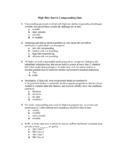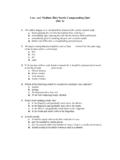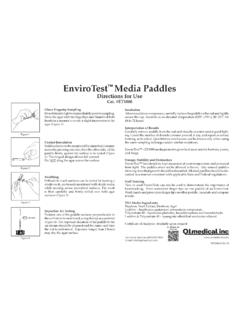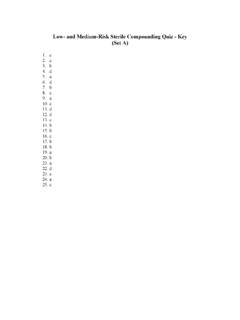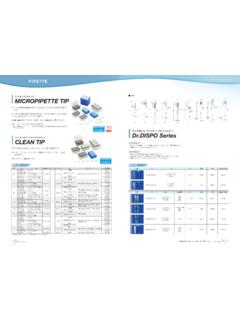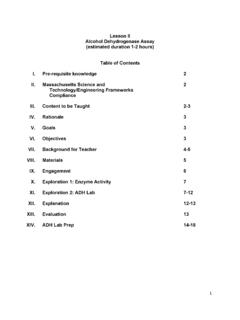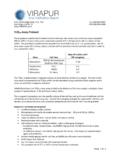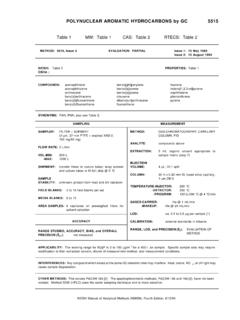Transcription of ANALYTICAL REPORT: Comparison of the Microbial …
1 FOCUS Scientific Services LLC 44 Rolling Hill Drive Morris Township, NJ 07960 This report is the sole property of the client and Focus Scientific LLC (FS Services LLC). It is protected by provisions outlined in original Terms and Conditions. FOCUS Scientific Services LLC ANALYTICAL REPORT: Comparison of the Microbial Recovery Efficacy of QI Medical EnviroTest Paddles versus a Conventional Contact Plate REPORT: FS-QI-GM-003 Study Manager: Anthony Grilli, MS Principal Consultant Bring your project into FOCUS for a clear resolution Page 2 of 8 July 21, 2014 Comparison of the Microbial Recovery Efficacy of QI Medical EnviroTest Paddles versus a Conventional Contact Plate Abstract: The EnviroTest paddle is a convenient tool for recovering Microbial contaminants from compounding pharmacy surfaces. The paddle shape offers advantages to conventional round contact plates in its ability to reach corners and follow the curves of door knobs, light switches and equipment controls; these are all places where either frequent personnel contact or accumulation of organic matter is known to be high.
2 The paddle is attached to a screw cap closure which when replaced to the rigid test tube container remedies the problems of condensation migration, closure flipping and container breakage which one encounters when using conventional contact plates. However, the benefits of shape and packaging are lost if the paddle does not recover Microbial contaminants from compounding pharmacy surfaces as effectively as conventional contact plates. A pair of controlled studies were performed at a cGMP laboratory with the purpose of 1. Study #1 - Comparing each device s (EnviroTest and contact plate) ability to lift and grow dried microbes from typical compounding surfaces; and, 2. Study #2 - Evaluating the nutritive properties of each device s media component. This study was designed to stress the ability of the EnviroTest screw-cap package to maintain the nutritive agar by comparing aged EnviroTest to fresh control media.
3 The data generated from these studies verify that the EnviroTest paddle is as effective as conventional contact plates as an environmental monitoring tool. Equivalency Test Organisms EnviroTest versus Contact Plate Recovery of dried inocula from compounding surface coupons by an exhaustive recovery method Gram positive cocci Equivalent Yeast Equivalent Bacterial Spores Equivalent Recovery of dried spores from compounding surfaces versus a rinsed and plated sample Bacterial Spores Equivalent Growth promotion and nutritive properties of media Aged EnviroTest and fresh growth media Gram positive cocci Equivalent Gram negative rods Equivalent Yeast Equivalent Mold Equivalent Bacterial spores Equivalent Testing Summary: Test Species: Bacillus subtilis ATCC 6633 NCTC 10400 Staphylococcus aureus ATCC 6538 NCTC 10788 Pseudomonas aeruginosa ATCC 9027 NCTC 12924 Candida albicans ATCC 10231 NCTC 3179 Aspergillus brasiliensis ATCC 16404 NCTC 2275 Bring your project into FOCUS for a clear resolution Page 3 of 8 July 21, 2014 Test species were prepared from BioBall inoculation products, a precise quantitative inoculum patented and manufactured by Biomerieux.
4 The BioBall product uses a flow cytometer to dispense individual cells and count them in each inoculum, resulting in a very precise number of cells. BioBall utilize NCTC cultures which are equivalent to the ATCC Strains listed above. Devices: 1. EnviroTest Tryptic Soy Agar Paddles: contains tryptose, yeast extract, dextrose, agar, lecithin and polysorbate 80, Lot # 1556804, 1564724, 15790764 2. EnviroTest Malt Extract Agar Paddles: contains malt agar, yeast extract, dextrose, lactic acid, antibiotics, agar, lecithin, polysorbate 80, histidine, and thiosulfate Lot # 1562027 3. EMD Millipore Tryptic Soy Agar Contact Plates: contains tryptose, yeast extract, dextrose, agar, lecithin and polysorbate 80. Lot # 123051, 122852, 125136 4. EMD Millipore Malt Extract Agar Contact Plates: contains maltose, dextrin, glycerol, peptone, agar, lecithin and polysorbate 80. Lot #1331518 Surfaces used in Study #1: Vinyl Tile Flooring Material Borosilicate Glass Stainless Steel Control Media used in Study #2: 1.
5 Tryptic Soy Agar Plus Neutralizers (TSA+) Control Plates: contains tryptose, yeast extract, dextrose, agar, lecithin, and polysorbate 80. Prepared by the testing laboratory from a commercial blend. 2. Malt Extract Agar Plus Neutralizers (MEA +) Control Plates: contains maltose, dextrin, glycerol, peptone, agar, lecithin and polysorbate 80. Prepared by the testing laboratory from a commercial blend. Procedure for Study #1 - Microbial Recovery from Compounding Surfaces: 1. Coupon Preparation: a. Materials (vinyl, glass or stainless steel) were cut to 2 x 2 inch coupons b. The steel and glass coupons were cleaned by rinsing with DI water and sterilized in an autoclave c. The vinyl coupons were cleaned by rinsing with DI water and sterilized in an ETO sterilization cycle. The coupons were allowed to aerate for 4 days prior to testing. 2. Microbial inoculation: a. BioBall culture preparations were removed from freezer and allowed to equilibrate at room temperature prior to use.
6 B. BioBall was transferred into the rehydration fluid, the cap was replaced, and the inoculum dissolved for 30 seconds. c. The resulting mixture was vortexed for 5 seconds or until BioBall was completely dissolved and there was a visibly homogenous distribution. Bring your project into FOCUS for a clear resolution Page 4 of 8 July 21, 2014 d. 9 replicates of each coupon type were placed in 9 individual petri plates. 3 plates were labelled for Contact, 3 were labelled for EnviroTest, and 3 were labelled for Control. e. Each of the replicate coupons was inoculated with mL of x 103 cfu of prepared Microbial suspension. The inoculum was spread evenly across the coupon, leaving approximately inch on the left and right side of the coupon free of inocula. f. A 10 mL phosphate buffered saline blank was simultaneously inoculated with mL of x 103 cfu. g. Inoculated coupons were dried in a 35 39 C incubator with petri plate lids on.
7 Inoculum was allowed to dry completely. 3. Enumeration: a. Contact Plates: Surface of coupon was pressed with a contact plate, firmly enough so that the entire surface of the agar was in contact with the coupon. Plate was held in this position for 5 seconds. Contact plate was removed and lid was replaced. Each tile was sampled an additional four times, with four fresh contact plates, so that an initial recovery percentage could be calculated. b. EnviroTest: Surface of coupon was pressed with a paddle and the paddle was gently rocked. The paddle was then flipped and the other side was pressed to the other half of the coupon, again slightly rocking the paddle. The paddle was removed from coupon and placed back in the tube. Each tile was sampled an additional four times, with four fresh paddles, so that an initial recovery percentage could be calculated. c. Control Tile: Inoculated coupon was placed in whirl pack bag with 10 mL phosphate buffered saline.
8 The coupon was thoroughly massaged through the bag to dislodge all inoculum from coupon. The resulting phosphate buffered saline was passed through a micron filter. Filter was placed on TSA+ for bacteria and MEA+ for fungi. d. Bacterial plates were incubated at 30 - 35 C for 3 days, fungal plates were incubated at 20 25 C for 5 days and colony forming units were counted. 4. Calculations: a. Percent Recovery = Sample 1 cfu x 100 Total cfu of Samples 1 5 b. Comparative recovery = Contact Device cfu x 100 Control Tile cfu Bring your project into FOCUS for a clear resolution Page 5 of 8 July 21, 2014 Study #1 Results: Table 1: Percent recovery of test species from various test surfaces as determined by exhaustive recovery Bacillus subtilis Candida albicans Staphylococcus aureus EnviroTest Contact Plate EnviroTest Contact Plate EnviroTest Contact Plate Vinyl 32% 24% 33% 33% 36% 22% Glass 61% 42% 94% 88% 71% 43% Steel 43% 35% 84% 88% 64% 52% Table 1.
9 Discussion: The exhaustive recovery data clearly demonstrate that the contact plates and EnviroTest paddles are comparative methods for determining Microbial populations on surfaces, and only a fraction of the population is actually recovered from any surface using either device on the first pressing. This is an important point to remember when setting Alert and Action Levels for an environmental monitoring program, as the counts achieved are meant to be relative to one another and then trended over time, they do not represent an absolute value of microbes on a surface. The exhaustive recovery efficiency is similar on both devices across material types, with vinyl flooring showing the worse initial recovery, and the smooth surfaces of glass and steel offering better opportunity for high recovery. Table 2: Percent recovery of B. subtilis spores from various surfaces as determined by Comparison to a control tile.
10 Bacillus subtilis EnviroTest Contact Plate Vinyl 27% 21% Glass 55% 31% Steel 53% 33% Table 2. Discussion: Bacillus spores are the ideal test subjects to compare counts between products: they are ubiquitous, airborne, and desiccant resistant, alleviating concern of test species viability during drying cycles. In fact, comparative counts utilizing plate count methods were attempted with vegetative cells but the results were too variable to make any conclusions. We believe the variability was due to the impact of drying on vegetative culture viability between sampling. Regardless, when counts of a dried Bacillus inoculum recovered from a surface monitoring device are compared to those recovered by vigorous washing and rinsing, it is clear once again that not all surface contaminants are picked up by the agar press on the first pass by either device. The two devices are equivalent in their ability to recover dried spores from compounding surfaces.
